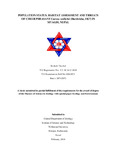Please use this identifier to cite or link to this item:
https://elibrary.tucl.edu.np/handle/123456789/1435| Title: | Population Status, Habitat Assessment and Threats of Cheer Pheasant Catreus Wallichii (Hardwicke, 1827) in Myagdi, Nepal |
| Authors: | Chokhal, Keshab |
| Keywords: | Population;Status |
| Issue Date: | 2018 |
| Publisher: | Central Department Zoology |
| Abstract: | Cheer Pheasant (Catreus wallichii) is a resident bird of Western Himalaya as a globally vulnerable and nationally endangered species. This study aimed to assess population status, determine the habitat use and explore the conservation threats of Cheer Pheasant in Myagdi. Dawn call count method was used to estimate the population of Cheer Pheasant and survey was conducted in 300m radius (n=25) call count station. As well as that quadrate method was laid down for the vegetation density quantification and major threats were identified by questionnaire method. Altogether 38 breeding individual with 96- 240 population size of Cheer Pheasant was estimated. Population density 7 bird/km 2 has been estimated in study area whereas entire detection rate was 1.50 bird/station. Elevation 1800-2400m was the specific range of Cheer Pheasant whereas a maximum of 8 individuals were recorded from lowest elevation 1800m in Daduwa. East and South aspects with moderately steep slope (10 0 35 0 ) and steep slope (35 0 -67 0 ) were the favorable specific geographical features of this species. Corresponding to habitat feature was analyzed by generalized linear model methods however population was directly correlated with the ground cover (95%CF, P<0.00011), shrubs density (95%CF, P<0.0034) and soil temperature (95%CF, P<0.0293). Almost habitats were located in around the human settlement (95%CF, P>0.064) although the humidity (95CF, at P>-0.099) and tree density (95CF, at P>-0.021) were negative effects on the Cheer distribution. Poaching, grazing, fire and habitat deterioration were the major threats to Cheer Pheasant. Species action plan and conservation awareness program should be necessary for the minimization of these threats in Myagdi. |
| URI: | http://elibrary.tucl.edu.np/handle/123456789/1435 |
| Appears in Collections: | Zoology |
Files in This Item:
| File | Description | Size | Format | |
|---|---|---|---|---|
| Thesis.pdf | 3.21 MB | Adobe PDF |  View/Open |
Items in DSpace are protected by copyright, with all rights reserved, unless otherwise indicated.
